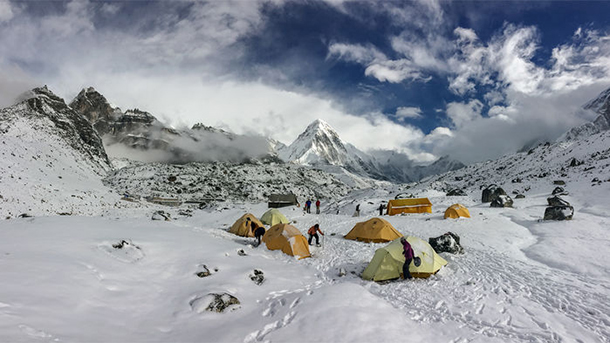Melting glaciers around Mount Everest may be forming killer lakes
By Katherine Kornei Of the roughly 198,000 glaciers on the planet, more than a quarter are found in the Himalayas. But even this frigid expanse of ice and snow—home to nine of the world’s 10 highest peaks—is reeling from climate change. Many Himalayan glaciers are receding—and a new study of 32 glaciers around Mount Everest has found that those terminating in lakes have lost more ice mass than landlocked glaciers. That’s a worrying trend because many glacial lakes form behind unstable debris dams that are poised to collapse and send disastrous floods hurtling down valleys.
Himalayan glaciers are losing ice mass because of decreased snowfall and higher average air temperatures that melt existing ice. “The landscape is primed for lake development,” says Owen King, a glaciologist at the University of Leeds in the United Kingdom, who led the study. As meltwater lakes swell, the risk of a breach heightens. According to Joseph Shea, a glacier hydrologist at the University of Saskatchewan in Saskatoon, Canada, who was not involved in the research, “Bigger lakes may increase the risk of catastrophic dam failure.”
Just that happened in 1985, when a debris dam at Dig Tsho, a glacial lake in eastern Nepal, burst, spilling millions of cubic meters of water on the village of Ghat. The flooding destroyed houses, bridges, and a new hydroelectric plant. To avert a similar disaster, the Nepalese government last year drained part of Imja Tsho, one of the fastest-growing glacier lakes in the country.
Now, King and his collaborators have used satellite data to reveal how nine glaciers terminating in lakes and 23 terminating on land in Nepal and Tibet changed over 15 years. Armed with digital elevation maps obtained in 2000 and 2015 and images of the glaciers themselves, the team compared how the ice mass, ice area, and height of the glaciers changed. They found that the glaciers melting into lakes had lost 32% more ice mass per year than land-terminating glaciers, they report this month in The Cryosphere. The lake-terminating glaciers had also lost more height and area than the landlocked glaciers.
King’s team believes lake water erodes the underside of glaciers, causing them to calve icebergs. That process would efficiently remove ice mass, they suggest. But other scientists say the issue isn’t settled. “It’s still unclear why lake-terminating glaciers are losing more mass than land-terminating glaciers,” says Patrick Wagnon, a glaciologist at the French National Research Institute for Sustainable Development in Marseille, who was not involved in the study.
Fresh findings may shed further light. King and his colleagues, for instance, recently returned from two expeditions to the Everest region for a close-up look at how glacial lakes influence glaciers. “I’m knee-deep in field data,” he says. The researchers also plan to study glacier changes in the Himalayas over longer timescales, using satellite images taken as far back as the 1970s.
source; “Science”



comment 0